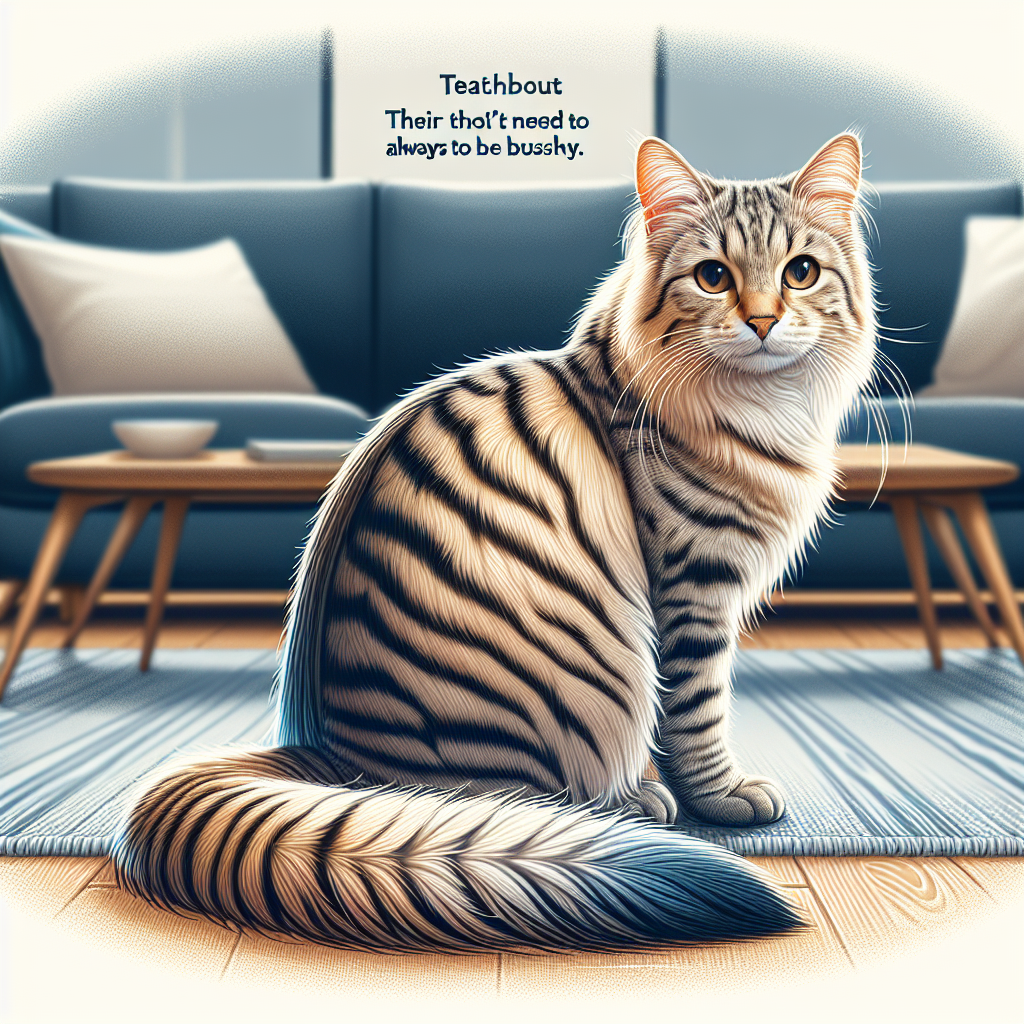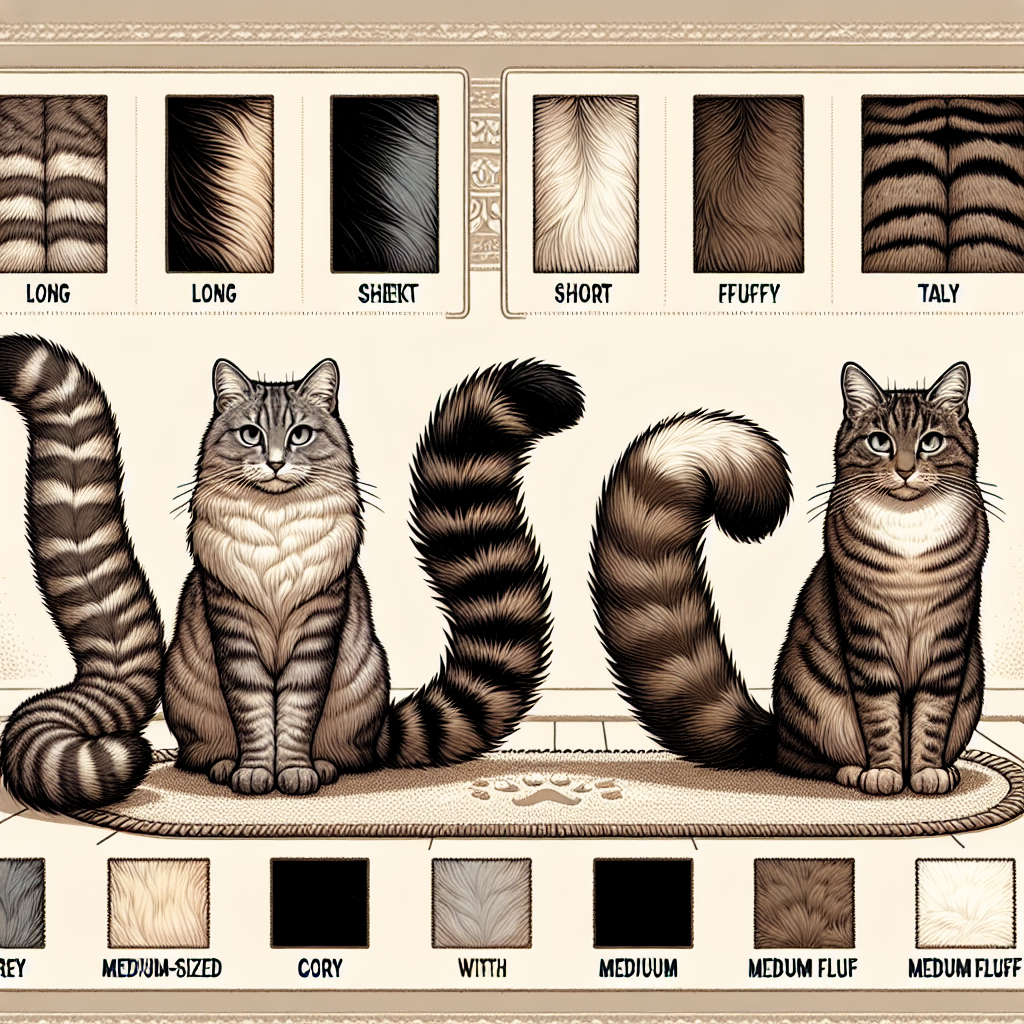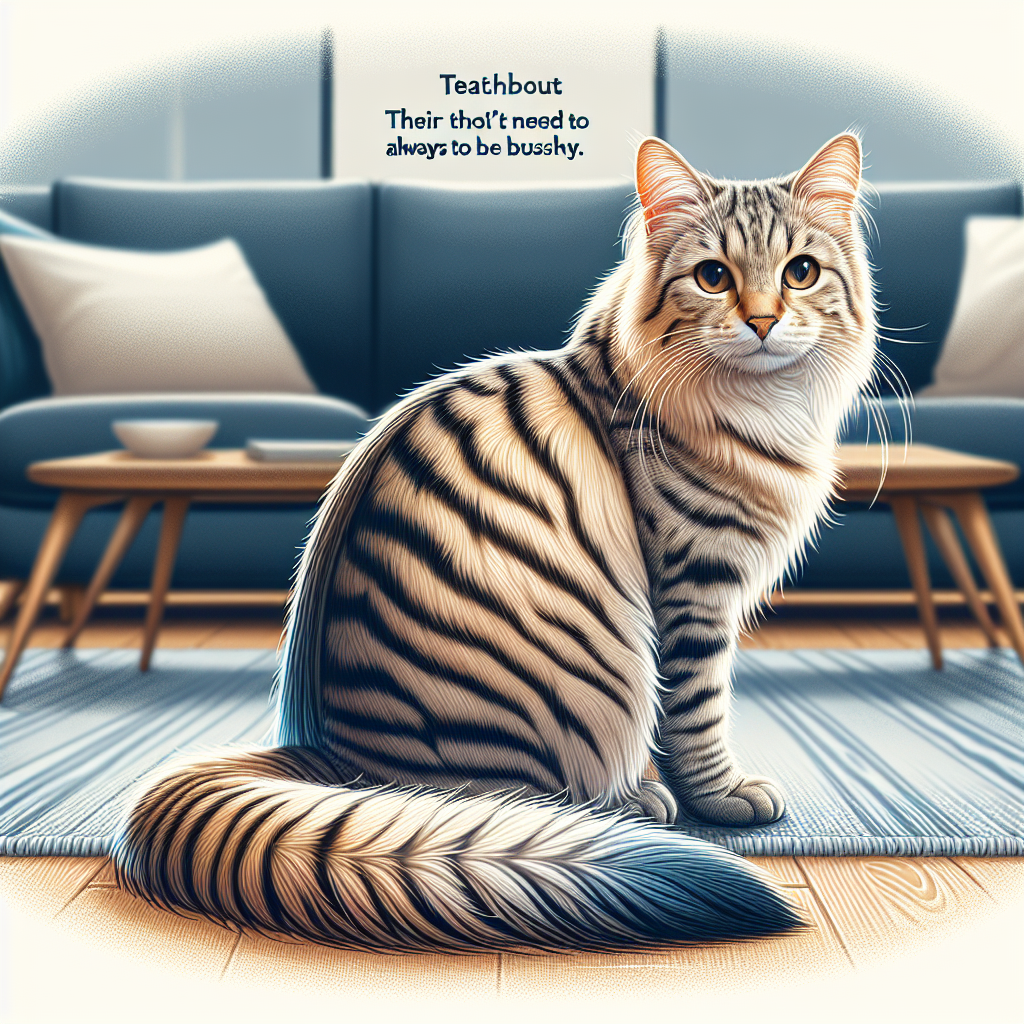If you’re a fan of cats, you’ve probably heard the old myth that tabby cats are known for their bushy tails. Well, it’s time to debunk that belief once and for all. Contrary to popular belief, tabby cats, characterized by their beautiful coat patterns, don’t necessarily have bushy tails. In fact, just like any other breed, tabbies can have tails that vary in size and fluffiness. So, let’s set the record straight and uncover the truth about tabby cats and their tails.
1. What is a Tabby Cat
1.1 Definition
A tabby cat is not a specific breed of cat but rather a coat pattern that is seen in many different breeds. Tabby cats have a distinct coat pattern that features stripes, spots, or swirls. The pattern is typically seen on their body, but it can also extend to their tail, legs, and face. Tabby cats can come in a variety of colors, including brown, gray, orange, and even silver.
1.2 Tabby Cat Characteristics
In addition to their unique coat pattern, tabby cats have some distinctive characteristics. They are known for their playful and friendly nature, making them popular pets. Tabby cats are also recognized for their intelligence and adaptability. They are often good with children and other animals, making them a great choice for families.
2. The Tail of a Tabby Cat
2.1 General Information
The tail of a tabby cat is an integral part of their body and plays various roles in their daily life. It is an extension of their spine and is made up of bone, muscles, and nerves. The tail serves multiple purposes, including balance, communication, and aiding in different behaviors such as hunting and play.
2.2 Variations in Tail Length
Tabby cats can have tails of varying lengths. Some tabby cats have shorter tails, while others have longer tails. The length of the tail can be influenced by genetics, environmental factors, and individual variation. Regardless of length, tabby cat tails are flexible and highly expressive.
2.3 Other Tail Features
In addition to their varying lengths, tabby cat tails can also have other unique features. Some tabby cats may have a slight curve or kink in their tail, adding to their individuality. The fur on the tail can also differ in texture, ranging from smooth to fluffy.
2.4 Role of Genetics
Genetics plays a significant role in determining the characteristics of a tabby cat’s tail. The genes responsible for coat patterns and tail traits are passed down from their parents. Variations in tail length, shape, and fur texture can be inherited and influenced by the genetic makeup of the cat.

3. The Myth of Tabby Cats Having Bushy Tails
3.1 Historical Origins of the Myth
The misconception that tabby cats have bushy tails has its roots in historical representations of cats. In many cultures and art forms, cats, including tabby cats, were depicted with exaggerated tails as a symbol of power and mystique. Over time, this portrayal influenced the perception that a tabby cat’s tail is inherently bushy.
3.2 Misconceptions and Misinterpretations
The myth of tabby cats having bushy tails is primarily a result of misconceptions and misinterpretations. While some individual tabby cats may have bushy tails, it is not a defining characteristic of the breed. Tabby cats can have tails of various lengths, textures, and shapes, just like any other cat.
3.3 Variations in Tabby Cat Tails
Tabby cats exhibit a wide range of tail variations. Some tabby cats may have thin tails that taper to a point, while others may have thick and fluffy tails. The tail pattern can also differ, with some tabby cats having stripes or spots extending from their body onto their tail. These variations showcase the diverse nature of tabby cat tails.
4. Debunking the Myth
4.1 Scientific Studies and Research
Scientific studies and research have consistently shown that there is no correlation between the tabby coat pattern and tail bushiness. Various studies have examined the genetic factors influencing tail characteristics in cats, debunking the myth of tabby cats exclusively having bushy tails. These studies emphasize the importance of individual variation and genetics in determining tail traits.
4.2 Expert Opinions
Experts in the field of feline genetics and behavior have also weighed in on the myth of tabby cats having bushy tails. They highlight the diverse nature of tabby cat tails and emphasize that tail bushiness is not exclusive to tabby cats but can be seen in other cat breeds as well. Expert opinions provide valuable insights into the fallacy of this widespread myth.
4.3 Anecdotal Evidence
Anecdotal evidence from tabby cat owners further supports the debunking of the myth. Many tabby cat owners have reported owning cats with a variety of tail types, including slender, fluffy, and everything in between. These personal experiences demonstrate the individual differences in tabby cat tails and contradict the misconception of inherent bushiness.
4.4 Comparative Analysis with Other Cat Breeds
Comparing tabby cats with other cat breeds further emphasizes the fallacy of the myth. Many non-tabby cat breeds can exhibit bushiness in their tails, proving that this trait is not exclusive to tabby cats. Drawing comparisons between different cat breeds helps dispel the notion that all tabby cats have bushy tails.

5. Factors Influencing Tail Appearance in Tabby Cats
5.1 Genetics
As with other physical traits, genetics play a crucial role in determining the appearance of a tabby cat’s tail. The unique coat patterns and tail characteristics of tabby cats are influenced by specific genes that are passed down through generations. The combination of genetic factors inherited from both parents contributes to the final tail appearance of each individual tabby cat.
5.2 Individual Variation
Just as every cat is unique, so is each tabby cat’s tail. Even within the same litter, tabby kittens can have different tail lengths, textures, and shapes. Individual variation is an essential factor contributing to the diversity of tabby cat tail appearances.
5.3 Environmental Factors
Environmental conditions can also influence the appearance of a tabby cat’s tail. Factors such as climate and temperature may impact the growth and density of the fur on their tail. Additionally, grooming habits can also affect the overall appearance and condition of the tail.
5.4 Grooming Habits
Regular grooming is crucial for maintaining the health and appearance of a tabby cat’s tail. Proper grooming helps keep the fur clean, tangle-free, and prevents matting. The grooming habits of the cat, along with the owner’s care, can influence the overall appearance of the tail.
5.5 Health and Nutrition
The overall health and nutrition of a tabby cat can also impact the appearance of their tail. Cats in good health generally have a glossy, well-maintained coat and a healthy tail. Providing a balanced diet, regular veterinary care, and addressing any underlying health issues can contribute to a healthy and attractive tail.
6. Common Misconceptions about Tabby Cat Tails
6.1 Confusion with Other Cat Breeds
One common misconception is mistaking other cat breeds for tabby cats based on similar tail characteristics. Certain breeds, such as Maine Coons or Norwegian Forest Cats, may have bushy tails, leading to the confusion and assumption that all tabby cats have bushy tails.
6.2 Pop Culture Influence
Pop culture often perpetuates stereotypes and generalizations about tabby cats and their tails. Movies, television shows, and even cartoons may portray tabby cats with specific tail characteristics, influencing public perception and fueling misconceptions.
6.3 Stereotypes and Generalizations
Stereotypes and generalizations about tabby cats can also contribute to the misconceptions surrounding their tails. These stereotypes may imply that all tabby cats have a particular type of tail, reinforcing the myth rather than acknowledging the individuality and diversity among tabby cat tails.
7. Appreciating the Diversity of Tabby Cat Tails
7.1 Tail Types: Thin, Fluffy, Long, Short
Tabby cats exhibit a wide variety of tail types. Some tabby cats have thin, elegant tails that taper to a point, while others have thick and luxuriously fluffy tails. The length of the tail can also vary, with some cats having longer tails compared to others. These diverse tail types contribute to the individuality and beauty of tabby cats.
7.2 Tail Patterns and Colors
In addition to their tail type, tabby cats also showcase a range of tail patterns and colors. Tabby cat tails can feature stripes, spots, or swirls that extend from their body, creating a visually stunning display of patterns and colors. Each tabby cat’s tail pattern and coloration are unique, adding to their charm.
7.3 Unique Tail Features
Tabby cat tails can have unique features that make them stand out. Some tabby cats may have a slight curve or kink in their tail, further enhancing their individuality. These unique tail features contribute to the distinctive appearance of each tabby cat.
7.4 Tail Expressions and Communication
Tabby cats use their tails as a means of communication. A happy and content tabby cat may hold their tail high in the air, while a fearful or defensive cat might tuck their tail tightly between their legs. The position, movement, and expression of a tabby cat’s tail can convey their emotions, allowing for non-verbal communication with humans and other animals.
8. Caring for Tabby Cat Tails
8.1 Tail Hygiene
Proper tail hygiene is crucial for maintaining the health and appearance of a tabby cat’s tail. Regularly inspecting the tail for any signs of injury, parasites, or matting is essential. If necessary, gently combing or brushing the tail can help remove any tangles or debris that may accumulate.
8.2 Grooming Tips
In addition to tail hygiene, regular grooming sessions are beneficial for preserving the beauty of a tabby cat’s tail. Brushing the tail helps remove loose fur, prevents matting, and enhances the overall appearance. It is important to choose a grooming tool suitable for the texture and length of the cat’s tail.
8.3 Tail Injuries and Health Issues
Tabby cat owners should be vigilant in monitoring their cat’s tail for any signs of injury or health issues. Tail injuries, such as fractures or sprains, can occur due to accidents or rough play. Health issues, such as infections or tumors, may also affect the tail. Seeking prompt veterinary care is necessary if any issues are detected.
8.4 Professional Veterinary Care
Regular visits to the veterinarian play a vital role in maintaining a tabby cat’s overall health, including their tail. Veterinarians can provide guidance on tail care, check for any underlying health concerns, and address any specific issues related to the tail.
9. The Role of Tabby Cat Tails in Feline Behavior
9.1 Balance and Coordination
One crucial function of a tabby cat’s tail is to aid in balance and coordination. The tail acts as a counterbalance, allowing the cat to navigate narrow spaces, walk along ledges, and leap with precision. The flexibility and agility of the tail contribute to a tabby cat’s impressive balance and coordination skills.
9.2 Communication Signals
Tabby cats use their tails as a form of communication with humans and other animals. A wagging tail can indicate excitement or playfulness, while a swishing or puffed-up tail may convey agitation or fear. The position and movement of the tail can signal various emotions and intentions, enabling effective communication.
9.3 Mood Indicators
The position of a tabby cat’s tail can provide insight into their current mood and emotional state. A relaxed and lowered tail signifies contentment, while an upright or bristled tail may indicate alertness or aggression. Understanding and interpreting these tail cues can help foster a better understanding of a tabby cat’s emotions and needs.
9.4 Play and Hunting Behaviors
Tabby cats often engage in play and hunting behaviors, and their tails play a role in these activities. A twitching or pouncing tail is a common sight in a playful tabby cat, indicating their excitement and readiness for interactive play. In hunting scenarios, the tail may assist in maintaining focus and coordination during stalking and capturing prey.
10. Celebrating Tabby Cat Diversity
10.1 Different Tabby Cat Breeds
While tabby cats themselves are not a specific breed, the tabby coat pattern can be found in various cat breeds. Celebrating the diversity of tabby cat breeds showcases the wide range of tail variations and patterns seen in the feline world. From Maine Coons to Abyssinians, each tabby cat breed carries its unique traits and tail characteristics.
10.2 Unique Tails from Around the World
Tabby cats can be found in different parts of the world, each with their own unique tail characteristics. For example, American Bobtails have short, stubby tails, while Japanese Bobtails have distinctive pom-pom-like tails. Exploring the various tail types seen in tabby cats from different regions adds to the appreciation of their diversity.
10.3 Tabby Cat Tail Contests and Competitions
In some feline-focused events and shows, tabby cats may participate in tail contests and competitions. These events highlight the beauty and uniqueness of tabby cat tails, allowing owners and enthusiasts to showcase their cat’s tail attributes. Participating in such competitions can be a fun way to celebrate and appreciate the diversity of tabby cat tails.
In conclusion, the myth that tabby cats have bushy tails is just that – a myth. Tabby cats exhibit a wide range of tail characteristics, including variations in length, texture, and shape. Genetics, individual variation, environmental factors, and grooming habits all contribute to the appearance of a tabby cat’s tail. It is important to appreciate the diversity and uniqueness of tabby cat tails, debunking misconceptions and fostering a better understanding of these beloved feline companions.

